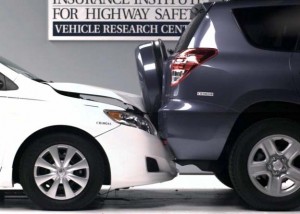The number of fatalities caused when passenger cars and SUVs collide has declined by almost two-thirds in recent years.
With more sport-utility vehicles on the road than ever, that’s a significant shift since many safety experts began tarring popular products like the Ford Explorer and Toyota 4Runner as highway menaces a decade ago. A new report by the Insurance Institute for Highway Safety credits improved designs in both passenger cars and sport-utes for the dramatic drop in fatalities.
A decade ago, reports IIHS, collisions between cars and an SUV weighing in between 3,000 and 3,499 pounds resulted in 44 deaths per million registered vehicles. Between 2008 and 2009, however, the fatality rate had plunged to just 16 per million vehicles.
Even for crashes involving the heftiest of SUVs, those weighing in at 5,000 pounds or more, death rates have fallen by nearly half, according to the study.
“New designs have made a big difference on the road,” said the report’s co-author and IIHS chief administrator Joe Nolan.
Part of the problem in the past was an issue called car-truck compatibility. SUVs tended to have higher bumper than passenger cars and would often climb on top of a sedan or coupe in a collision. The National Highway Traffic Safety Administration asked the industry to come up with a solution and most major U.S., Asian and European makers agreed following a critical industry summit in 2003.
The target was September 2009, but many manufacturers already had launched critical changes before then. Among other things they lowered critical truck crash structures and realigned bumpers so they would directly impact those same components in passenger cars.
“By working together, the automakers got life-saving changes done quickly,” said Nolan.
Meanwhile, steps were taken to improve the safety of passenger cars, strengthening head protection, adding side-impact airbags and updating designs to better absorb and deflect the impact of collisions around the passenger compartment.
Significantly, collisions between two passenger cars, or between a passenger car and a minivan actually resulted in a slightly higher death rate than a car-truck crash in the 2008-2009 time period, noted the IIHS, an average 17 per million registered vehicles.
But, overall traffic fatalities have been steadily declining in recent years, reflecting the impact of better vehicle designs and the increased use of airbags and other high-tech safety systems.
While officials caution it’s still a sizable toll, U.S. highway deaths dropped to 32,788 in 2010, the lowest level since 1949, and a 3% dip from the year before.

